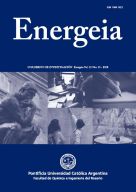Por favor, use este identificador para citar o enlazar este ítem:
https://repositorio.uca.edu.ar/handle/123456789/5870| Título: | Análisis comparativo de la captura y almacenamiento de CO2 por especies vegetales de tres ecosistemas en Perú | Autor: | Luccini, Eduardo Flores, M. Ramírez, K Pérez Pinedo, H. Herrera, Luis Alberto Parodi, M. Matar, Maricel Gómez Insausti, J. Barrea, L. Mechini, M. Calcagno, G. |
Palabras clave: | DIOXIDO DE CARBONO; VEGETACION; CARBONO; CAMBIO CLIMATICO; MITIGACION DE EMISIONES GASEOSAS | Fecha de publicación: | 2018 | Editorial: | Universidad Católica Argentina. Facultad de Química e Ingeniería "Fray Rogelio Bacon". Departamento de Investigación Institucional | Cita: | Luccini, E. et al. Análisis comparativo de la captura y almacenamiento de CO2 por especies vegetales de tres ecosistemas en Perú [en línea]. Energeia, 15(15), 2018. Disponible en: https://repositorio.uca.edu.ar/handle/123456789/5870 | Resumen: | Resumen: La capacidad de captación y almacenamiento de CO2 atmosférico por diferentes especies vegetales es un parámetro crucial a determinar ante el presente escenario de cambio climático planetario. En este trabajo se cuantifica y compara la captura y el almacenamiento de CO2 por la flora nativa de tres regiones muy disímiles de Perú, de las cuales algunas comparten especímenes en común. Las regiones comprendidas son el humedal costero de Villa María, el Lago Titicaca en el Altiplano de Puno y la selva amazónica de Loreto. El muestreo abarca desde especies gramíneas hasta arbóreas. Se delimitaron áreas representativas ocupadas homogéneamente por cada especie donde se realizaron muestreos de campo. En la etapa de laboratorio, el contenido de carbono en la estructura vegetal se determinó prioritariamente por método de “Walkley y Black” y la captura de dióxido de carbono se estimó mediante el “factor de conversión de carbono a dióxido de carbono”. Los valores de cantidad de dióxido de carbono capturado abarcan desde 44 tCO2/ha en la especie gramínea hinea del humedal costero hasta 644 tCO2/ha en árboles grandes de la selva amazónica. Abstract: The capacity for atmospheric CO2 uptake and storage by different native vegetal species is a crucial parameter to determine given the present planetary climate change scenario. In this work, the CO2 uptake and storage by native flora in three very different regions of Perú, several of them having common specimens, is quantified and compared. Spanned regions are the Villa María coastal wetland, the Titicaca Lake within the Puno Highland and the Loreto Amazonic jungle. Samples cover from grass up to trees. Representative areas were delimited, occupied mainly by homogeneous coverage of each species where field samplings were made. In the laboratory stage, the “Walkley and Black” method was used to determine the carbon content and the “carbon-to-carbon dioxide conversion factor” was used to estimate the carbon dioxide uptake. Carbon dioxide uptake values range from 44 tCO2/ha for the grass species of hinea within the coastal wetland up to 644 tCO2/ha for big trees within the Amazonia jungle. |
Cobertura Espacial: | PERU | URI: | https://repositorio.uca.edu.ar/handle/123456789/5870 | ISSN: | 1668-1622 | Disciplina: | INGENIERIA | Derechos: | Acceso Abierto | Fuente: | Energeia, Vol. 15, Nº 15, 2018 ISSN 1668-1622 |
| Aparece en las colecciones: | ENE 2018 Año 15 nro. 15 |
Ficheros en este ítem:
| Fichero | Descripción | Tamaño | Formato | |
|---|---|---|---|---|
| analisis-comparativo-captura-almacenamiento.pdf | 1,01 MB | Adobe PDF |  Visualizar/Abrir |
Visualizaciones de página(s)
1.031
comprobado en 30-abr-2024
Descarga(s)
1.243
comprobado en 30-abr-2024
Google ScholarTM
Ver en Google Scholar
Este ítem está sujeto a una Licencia Creative Commons

